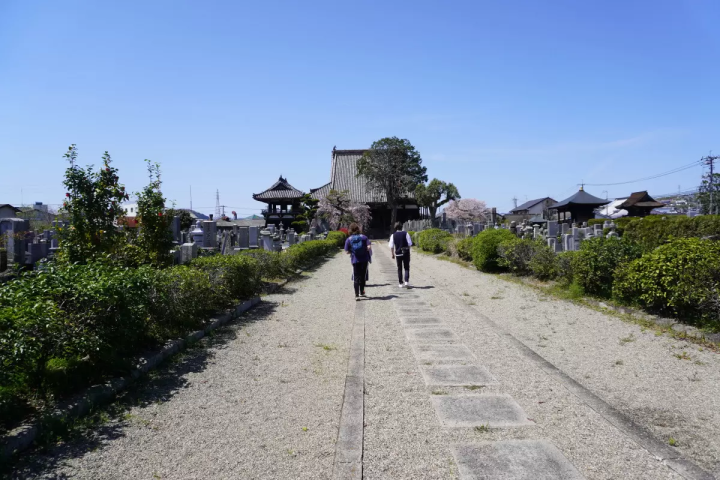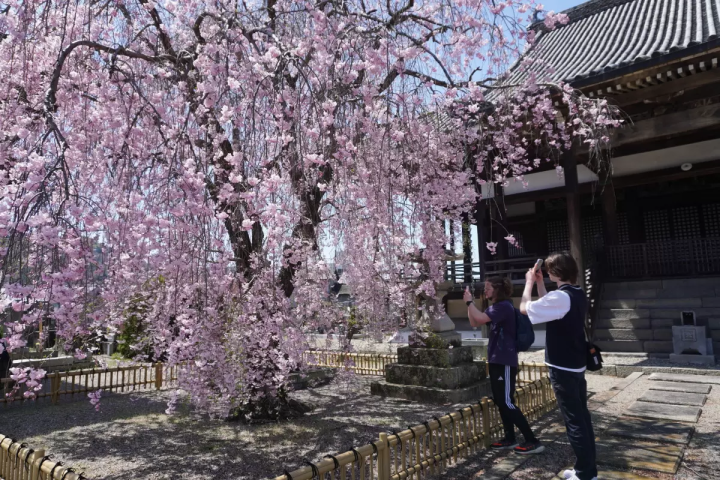The Josai district of Tsuyama City retains the atmosphere and streetscape of the Edo period and is the castle town's largest concentration of temples. On the "Okage Meguri with Guides" experience tour held in this district, the head priest of the temple will guide you through the history and charm of the temples with entertaining stories. This time, I joined a tour of temples and Zen meditation with three people living in Japan: an American, a German, and a Finnish person. Event period: April 1, 2024 (Monday) to March 31, 2025 (Monday) *Reservation required, some exclusion dates apply
2024.04.24Josai Town Walk "Exploring the blessings of our ancestors"

The area west of Tsuyama Castle, known as the Castle West District, is the castle town's largest concentration of temples, and retains the townscape and atmosphere of the Edo period. In 2020, the Castle West District was designated an Important Preservation District for Groups of Traditional Buildings.
The "Okage Meguri with Guides" is a walking tour of the Josai Townscape Preservation District, guided by the Josai Young Monks Association. You can choose from the following courses: Matcha Tea Course, Sutra and Buddha Copying Course, and Zazen and Meditation Course, and experience it at the temple.
*Advance registration is required to participate.
The tour starts from the Sakushu Folk Crafts Museum (Tsuyama Machi no Eki Josai)

Our tour of Okage begins at the Sakushu Folk Crafts Museum. Here we meet the head priest who will be our guide. Our group consisted of three people: an American, a German, and a Finnish person all living in Japan.
First, we were given an explanation about the history of the Izumo Kaido and why temples are concentrated in the Josai area. Apparently, temples were concentrated in the Josai area about 400 years ago to protect the castle town from enemies attacking from the west.
Town guide by the chief priest

We walked around the Josai district listening to explanations about the history and architecture. If we walked alone we would have just passed by places without noticing, but with a guide we learned and discovered many things, making the walk more enjoyable. Apparently the gates are high so that people can pass through on horseback.

This stone monument prohibits monks from eating alcohol and strong-smelling vegetables. One of the reasons for prohibiting strong-smelling vegetables is that monks would not be able to concentrate on their training if they became virile.

The bell tower is missing its bells, as they were salvaged to make up for the wartime metal shortage.

Musha-hashi. A slightly elevated passageway built inside the wall for surveillance and attacks against enemies. This passageway was at a suitable height for Japanese men to hide and move about without being seen from the wall, as the average height of adult Japanese men at the time was under 160cm. It seemed a little difficult for a tall Finnish man like him to hide and move around.
Temple Visit 1: Hongenji Temple

Hongenji Temple is the family temple of the Tsuyama clan, lords of Mori , and was built about 400 years ago in 1607 (Keicho 12). While I was praying, the head priest of Hongenji Temple happened to be passing by, and I was lucky enough to be able to see inside the temple.

As it was after the Flower Festival held on April 8th, the Buddha's birthday, Kanbutsu-e, the temple was decorated in a way that you don't normally see. The Flower Festival is open to the public.
As a foreigner, it was his first time to pray to Buddha, and it was a valuable experience for him. He learned the proper etiquette and followed the example of others as he prayed.
[Hongenji Temple]
Address: 1373 Odanaka, Tsuyama City, Okayama Prefecture
Temple Visit 2: Soeiji Temple

Soeiji Temple is the family temple of the mother (Keikain) of Tsuyama, the second lord of Tsuyama. 33 statues of Kannon Bodhisattva are enshrined in the Kannon Hall. I had the opportunity to try zazen at this temple.

This tomb is called Imobaka (taro tomb) because its shape resembles a taro. The graves of successive chief priests are lined up here.

The five-ringed pagoda at Soeiji Temple was built in stages from the mid- to late 17th century. It is a graveyard made for a feudal lord.
Zen meditation experience

First, you will be taught how to do zazen, including how to sit, how to clasp your hands, and how to breathe.

Next, we received an explanation about the Keisaku (Kyosaku), a stick used to strike practitioners. When a practitioner is unable to concentrate on zazen, the monk will hit them on the back with the Keisaku. This is said to be a way of encouraging the monk.

They actually hit us on the back with the keisaku stick. It was a much bigger shock than I had imagined, and it surprised me. I was even more surprised when I heard that in real training, the hits are even stronger. After about 10-15 minutes of zazen, our minds became a little calmer. It was a first-time experience for the three foreign visitors , and we were very satisfied to have been exposed to ancient Japanese culture. After the zazen experience, we were allowed to worship the 33 Kannon statues, which are said to be quasi-national treasures. (Photography is not permitted, so there are no photos.)
[Soeiji Temple]
Address: 1303-8 Odanaka , Tsuyama City, Okayama Prefecture
Temple visit 3: Myohoji Temple

The third place we were taken to was Myohoji Temple. It is said to be the largest Nichiren sect temple in the Mimasaka region. It was moved to its current location when Tsuyama was built.

On the day we visited, the weeping cherry trees in the temple grounds were in full bloom. Everyone was so moved by the beauty of the weeping cherry trees that they took lots of photos.
[Myoho-ji Temple]
Address: 65 Nishideracho , Tsuyama City, Okayama Prefecture
Stop by a retro sweet potato shop

Naganoya is a retro sweet potato shop in the Josai district. We had some incredibly sweet and fluffy sweet potatoes.

All three foreign visitors said, "This is the most delicious roasted sweet potato I've ever eaten!" [Yakiimo Naganoya] Address: 54-1 Tsuyama City, Okayama Prefecture Prefecture TEL: 0868-22-8445 Business period: October to April
Details of the Josai Town Walk "Exploring the blessings of the region with our guides"

"Okage Meguri with a Guide" is a walking tour of the town, visiting temples and shrines with the guidance of a monk. It is a tour recommended for both Japanese and foreign visitors who are interested in Japanese history and culture. In addition to the Zen meditation experience, there are also other programs available, such as the Matcha Course and the Sutra and Buddha Copying Course. There is also an option to take part in the Okage Meguri tour by rickshaw.
[Walking around Josai Town "A tour of the blessings of our ancestors"]
Event period: April 1, 2024 (Monday) to March 31, 2025 (Monday)
Event times: ①From 10:00, ②From 11:00, ③From 13:00, ④From 14:00, ⑤From 15:00
Travel time: Approximately 1 hour 30 minutes
Experience course: ① Matcha, ② Copying sutras and Buddha images, ③ Zen meditation and meditation
Meeting place: ① Sakushu Folk Crafts Museum (18 Nishiimamachi , Tsuyama City) or ② Josai Romankan (122 Tamachi, Tsuyama City) Number of participants: 2-8 people per time slot * Please inquire separately for groups
Participation fee: 1,000 yen (elementary school students and younger only pay the actual cost)
[
Dates: Saturdays and Sundays only
Travel time: Approximately 1 hour 30 minutes
Participation fee: 5,000 yen for one-seater, 6,000 yen for two-seater (3,000 yen per person)
How to apply: Make a reservation by phone at least one day before the desired date. *Please contact us separately for reservations after that date.
TEL: 0868-22-8688
Reception hours: 10:00-17:00
Closed: Mondays (or the following day if Monday is a public holiday)
The contents on this page may partially contain automatic translation.



![[Okayama] Temple Tour and Zen Meditation Experience with a Monk in the Josai District of Tsuyama Cityの画像](https://resources.matcha-jp.com/resize/720x2000/2024/04/24-177974.webp)